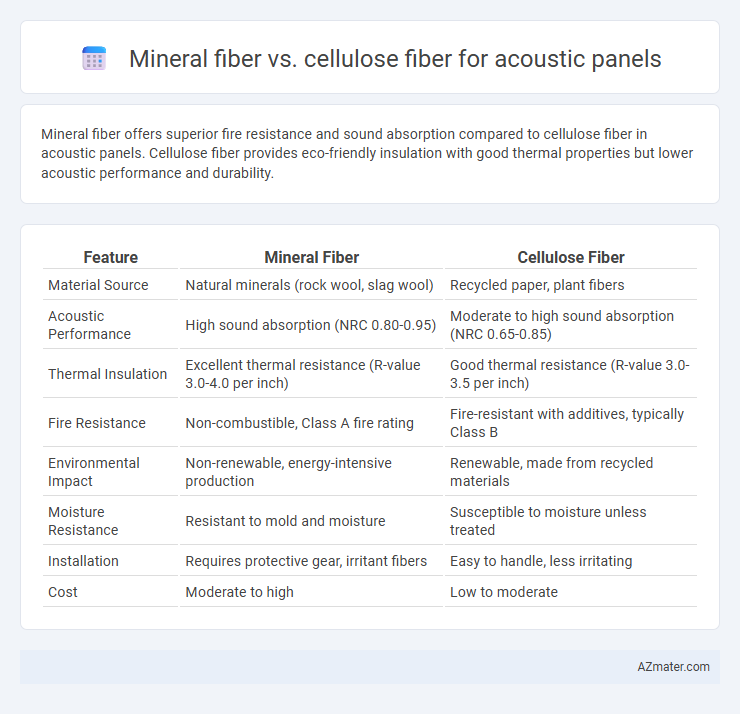Mineral fiber offers superior fire resistance and sound absorption compared to cellulose fiber in acoustic panels. Cellulose fiber provides eco-friendly insulation with good thermal properties but lower acoustic performance and durability.
Table of Comparison
| Feature | Mineral Fiber | Cellulose Fiber |
|---|---|---|
| Material Source | Natural minerals (rock wool, slag wool) | Recycled paper, plant fibers |
| Acoustic Performance | High sound absorption (NRC 0.80-0.95) | Moderate to high sound absorption (NRC 0.65-0.85) |
| Thermal Insulation | Excellent thermal resistance (R-value 3.0-4.0 per inch) | Good thermal resistance (R-value 3.0-3.5 per inch) |
| Fire Resistance | Non-combustible, Class A fire rating | Fire-resistant with additives, typically Class B |
| Environmental Impact | Non-renewable, energy-intensive production | Renewable, made from recycled materials |
| Moisture Resistance | Resistant to mold and moisture | Susceptible to moisture unless treated |
| Installation | Requires protective gear, irritant fibers | Easy to handle, less irritating |
| Cost | Moderate to high | Low to moderate |
Introduction to Acoustic Panel Materials
Mineral fiber and cellulose fiber are common materials used in acoustic panels, valued for their sound absorption properties and thermal insulation capabilities. Mineral fiber, often composed of glass wool or rock wool, provides high density and effective noise reduction through its porous structure, making it ideal for commercial and industrial settings. Cellulose fiber, typically derived from recycled paper products, offers eco-friendly benefits and efficient sound dampening, especially in residential applications where sustainability and breathability are priorities.
What Are Mineral Fibers?
Mineral fibers, commonly used in acoustic panels, are inorganic fibers derived from natural or synthetic materials such as rock wool, slag wool, and glass wool, known for their excellent sound absorption and thermal insulation properties. Unlike cellulose fibers, which are plant-based and made primarily from recycled paper, mineral fibers offer superior fire resistance and durability in high-moisture environments. Their dense, fibrous structure helps trap sound waves effectively, making them ideal for noise reduction in commercial and industrial acoustic treatments.
What Are Cellulose Fibers?
Cellulose fibers, derived from recycled paper, cotton, or wood pulp, provide excellent sound absorption in acoustic panels due to their porous and fibrous structure that traps sound waves effectively. Compared to mineral fibers, cellulose fibers offer a natural, eco-friendly alternative with enhanced airflow permeability, reducing echo and reverberation in rooms. These fibers are commonly used in environmentally conscious acoustic treatments, balancing sound performance with sustainability.
Sound Absorption Properties Comparison
Mineral fiber acoustic panels typically offer superior sound absorption coefficients, particularly in the mid to high-frequency range, due to their dense, fibrous structure that traps sound waves more effectively. Cellulose fiber panels provide good low-frequency absorption and are favored for their eco-friendly composition, but generally exhibit lower overall sound absorption compared to mineral fibers. Both materials contribute to improved acoustic performance, yet mineral fiber panels often achieve higher Noise Reduction Coefficient (NRC) ratings, making them preferable for spaces requiring enhanced sound dampening.
Thermal Insulation Performance
Mineral fiber acoustic panels offer superior thermal insulation with higher R-values, typically ranging from 3.0 to 4.0 per inch, effectively reducing heat transfer and improving energy efficiency in buildings. Cellulose fiber panels provide moderate thermal insulation, usually between 3.2 and 3.8 R-value per inch, benefiting from eco-friendly materials but often less consistent in performance due to variations in density and moisture resistance. Comparing thermal performance, mineral fiber panels maintain stability under varying temperature and humidity conditions, making them more reliable for sustained insulation in acoustic applications.
Fire Resistance and Safety
Mineral fiber acoustic panels offer superior fire resistance due to their non-combustible composition and ability to withstand high temperatures without emitting toxic fumes. Cellulose fiber panels, while sustainable and effective for sound absorption, have lower fire resistance and may require additional fire-retardant treatments to meet safety standards. For environments prioritizing fire safety, mineral fiber panels are the preferred choice due to their inherent fire-retardant properties and compliance with stringent building codes.
Environmental Impact and Sustainability
Mineral fiber acoustic panels are typically made from natural or recycled materials like basalt or slag, offering high durability but involving energy-intensive manufacturing processes that contribute to higher carbon emissions. Cellulose fiber panels, derived primarily from recycled paper, provide excellent biodegradability and lower embodied energy, making them a more sustainable option with reduced environmental impact. Both materials enhance indoor air quality by trapping sound, but cellulose fiber panels are favored for eco-friendly building certifications due to their renewable resource base and minimal chemical additives.
Installation and Maintenance Differences
Mineral fiber acoustic panels offer straightforward installation with lightweight, rigid boards that can be easily cut and fit into standard framing, while cellulose fiber panels often require loose-fill or denser application methods, complicating installation. Maintenance of mineral fiber panels involves occasional cleaning with vacuuming or gentle wiping, leveraging their durable surface, whereas cellulose fiber panels may be more vulnerable to moisture and require periodic inspection to prevent settling or mold growth. The difference in installation speed and moisture resistance impacts the long-term upkeep and performance of acoustic systems in varied environments.
Cost Analysis: Mineral vs Cellulose Fiber
Mineral fiber acoustic panels typically cost more upfront due to higher material and manufacturing expenses, while cellulose fiber panels offer a budget-friendly alternative with lower raw material prices and simpler production processes. Over the long term, mineral fiber panels may provide better durability and thermal performance, potentially reducing maintenance and replacement costs. Cellulose fiber panels, however, remain popular for eco-conscious projects where initial cost savings and sustainability are prioritized.
Which Acoustic Panel Material Should You Choose?
Mineral fiber acoustic panels offer superior sound absorption and fire resistance, making them ideal for commercial and industrial spaces requiring enhanced safety and performance. Cellulose fiber panels provide a more sustainable and eco-friendly option, with excellent thermal insulation and sound dampening qualities suitable for residential or eco-conscious projects. Choosing between mineral and cellulose fibers depends on specific acoustic requirements, environmental considerations, and fire safety regulations of the installation site.

Infographic: Mineral fiber vs Cellulose fiber for Acoustic panel
 azmater.com
azmater.com